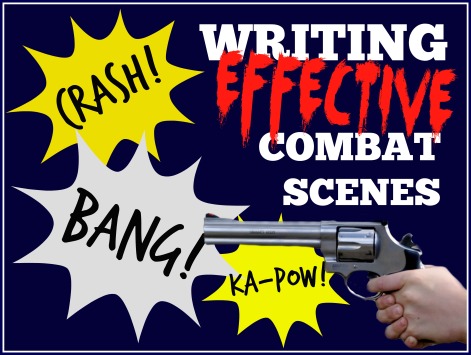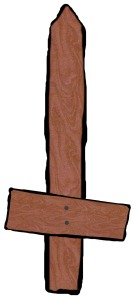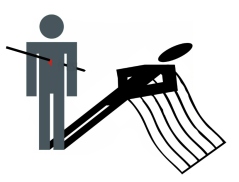 A combat scene that is well-written and well thought out adds excitement and tension to a story, whether it’s hand-to-hand combat between mortal enemies or an all-out four-army control-of-the-world skirmish of Tolkien magnitude. Writing a combat scene can be a complex process that may or may not work out, following a few simple rules can ease the headache a little by at least knowing which pitfalls to avoid.
A combat scene that is well-written and well thought out adds excitement and tension to a story, whether it’s hand-to-hand combat between mortal enemies or an all-out four-army control-of-the-world skirmish of Tolkien magnitude. Writing a combat scene can be a complex process that may or may not work out, following a few simple rules can ease the headache a little by at least knowing which pitfalls to avoid.
The decision to insert a fight scene into your plot should not be taken lightly. Its purpose should not only be to liven the plot, but to move it forward. If it doesn’t add to the story arc, it shouldn’t be there. Unless, of course, your story is about frivolous violence. In that case, you may not have enough. But for the most part, fight scenes needs to propel your story, add tension, and move the plot forward.
Here are some tips on how to do just that.
The Stakes
What are the stakes of your battle? What are the possible consequences for your main character if he doesn’t win? Will he die? Or is it worse? Will his army/companions/country fall into the hands of the enemy? Will his entire race be obliterated? Or is it better? Will he win the hand of the princess and the day? Will he amass a fortune that he will use to take over the world? The higher the stakes, the more tension there is to build. Make the consequences high enough that something MASSIVE will be lost or gained.
![]() Put it all on the line. Make your readers clamor for the outcome!
Put it all on the line. Make your readers clamor for the outcome!
Reloading Is for Wussies
One of the most abused tropes of gunplay is just how many shots characters have fired before  stopping to reload. If people knew the actual numbers, I think most of them would be surprised. Keep count sometime. Most go on for much longer than is realistic.
stopping to reload. If people knew the actual numbers, I think most of them would be surprised. Keep count sometime. Most go on for much longer than is realistic.
The capacity of fictional guns tends to be dependent on how much suspense the writer is looking for. The hero will always have plenty and the bad guy usually runs out. Sometimes the hero will have just enough for the fabled One Bullet Left. Reloading is usually only shown when the writer wants to show what a badass the hero is. If a character is firing an automatic weapon, you can rest assured that he won’t run out until he is 1) dead or 2) has killed everyone else. The only thing that can stop him is the inevitable gun jam. In reality, automatic weapons fire rounds really freakin’ fast. One good squeeze can empty a magazine in seconds.
Keep this in mind when you’re writing your combat scenes. You have the Wide Wide World of Web at your fingertips—don’t be afraid to use it. Do your research.
![]() If you don’t know how many rounds a certain gun will hold, don’t just make a number up. “She fired until the gun was dry” will suffice. And if you do know, don’t recount Every. Single. Bullet. Complete with make and model number. The reader will be more interested in how you maintain tension during the scene that your intricate knowledge of the gun.
If you don’t know how many rounds a certain gun will hold, don’t just make a number up. “She fired until the gun was dry” will suffice. And if you do know, don’t recount Every. Single. Bullet. Complete with make and model number. The reader will be more interested in how you maintain tension during the scene that your intricate knowledge of the gun.
The Stormtrooper Effect
An extension to the previous section is the Stormtrooper Effect. This is where the bad guys can’t aim and then gets killed with one shot from the good guy. It actually really will add more tension and interest to the scene if there is something at risk. If you go into the scene knowing that the hero won’t get hit, it takes something away from the reader and leaves them disappointed.
Clip? Or Magazine?
One is a clip. And one is a magazine. They are completely different, non-interchangable terms. Though it seems that not everyone knows this. With the raging debates about gun control, you can see how often the terms are misused.
Here is the difference:
A clip hold cartridges together with a strip. This makes it easier to load into the firearm.
A magazine is a detachable container that holds the cartridges and is generally inserted into the firearm to make it function. Sometimes a magazine can be loaded with a clip.
And the dictionary doesn’t always help.
Though most people would actually know what you were talking about if you interchanged the terms, those who do know the difference will judge you. Harshly. If you’re going to talk about guns, at least know what you’re talking about.
What Did You Say?!
Battle is noisy. If your character is in a gun battle and doesn’t have ear protection, there will likely be hearing loss or at least ringing in the ears. Explosions and gunfire, especially in an enclosed space, are literally deafening. Write accordingly.
The Sword Is Mightier than the Pen
 Know your swords. I don’t, but here are a few tips that I found. It seems like every warrior fights with a katana, when in reality, they were very rare. Katanas have a reputation as being the soul of the samurai who was considered to be the master of the weapon, but this, historically speaking, is false. There were no sword fights with katanas. It was usually one hit and the opponent was dead. Generally every cut from a katana is fatal. Real katanas also tend to completely destroy other real weapons.
Know your swords. I don’t, but here are a few tips that I found. It seems like every warrior fights with a katana, when in reality, they were very rare. Katanas have a reputation as being the soul of the samurai who was considered to be the master of the weapon, but this, historically speaking, is false. There were no sword fights with katanas. It was usually one hit and the opponent was dead. Generally every cut from a katana is fatal. Real katanas also tend to completely destroy other real weapons.
The katana was not the main weapon of the samurai on the field. They actually used their bows as they originated as mounted archers, the spear for infantry maneuvers to support the archers, swords on spears to counter cavalry, and early firearms. The katana was reserved for when the other weapons became unusable.
If you do it right, a good draw will make no sound. A bad draw is noisy. If your character is using a sword, make sure he or she uses it silently.
“Let Me Tell You Exactly How I am Going to Kill You in Excruciating Detail…”
Monologuing. Is there any other way to create tension during a fight scene? Yes. Yes, there  is. Make it real. Most warriors or fighters will not stop fighting to make a speech. When the adrenaline is flowing, as it usually is in battle, people generally won’t have the mental faculties to make a witty speech as entertaining as it is.
is. Make it real. Most warriors or fighters will not stop fighting to make a speech. When the adrenaline is flowing, as it usually is in battle, people generally won’t have the mental faculties to make a witty speech as entertaining as it is.
![]() Leave out long speeches during high-tension scenes. Replace them with more action (if it’s appropriate, of course).
Leave out long speeches during high-tension scenes. Replace them with more action (if it’s appropriate, of course).
What the Hell Happened?
 Make sure that you show the outcome of your battle. Did your hero get injured? Is he bleeding? And if he has sustained life-threatening injuries, he should probably die. Or be a robot (which could be kind of awesome.) It’s a cheat to the reader when the hero gets shot 15 times and then goes home for lemonade.
Make sure that you show the outcome of your battle. Did your hero get injured? Is he bleeding? And if he has sustained life-threatening injuries, he should probably die. Or be a robot (which could be kind of awesome.) It’s a cheat to the reader when the hero gets shot 15 times and then goes home for lemonade.
![]() Describe the battle scene. Let the reader know exactly what was gained or lost. If you can’t do these things, consider cutting the scene.
Describe the battle scene. Let the reader know exactly what was gained or lost. If you can’t do these things, consider cutting the scene.
Visualize the Scenes
If you, as the writer, can’t see the battle scene in your head, your readers are going to have a hard time too. Create a good visual image of every scene in your head as you write it. Create multiple ways of how the scene plays out. This is a good place to use your resources. Ask someone to read it. Can they see the same things you did while writing? If they can’t, rewrite it to make it more clear.
![]() Don’t ask your mom to read bloody torture scenes if she’s squeamish. She doesn’t like that.
Don’t ask your mom to read bloody torture scenes if she’s squeamish. She doesn’t like that.
Technically Speaking
When writing action, short sentences with little detail will create that frantic tempo you’re looking for. Reserve longer sentences for details during slower moments. Long sentences interrupt the pace. Action happens quickly, so write it so it can be read quickly. Use both to create tension and suspense.
![]() When someone is in a tense situation, running for their life, racing against time, or battling the enemy, they usually don’t take the time to stop and admire the scenery. They don’t start reminiscing about the love of their life or comment on the décor. If the adrenaline is pumping, their attention is on their survival—either theirs or someone else’s.
When someone is in a tense situation, running for their life, racing against time, or battling the enemy, they usually don’t take the time to stop and admire the scenery. They don’t start reminiscing about the love of their life or comment on the décor. If the adrenaline is pumping, their attention is on their survival—either theirs or someone else’s.
I hope that I have at least given enough information to help improve your combat scene or at least pointed you in the right direction. I am not a weapons expert and I don’t pretend to be (except at parties after seven beers), so if there is anything you would like to add from the realm of your expertise, please feel free to leave a comment. The more information the better! So let’s hear it!
Additional Resources:
List of Martial Arts
List of Weapons
List of Military Tactics
Insane (Yet Successful) Battle Tactics from History
Badass of the Week
VIDEO: The Difference Between a Clip and a Magazine
Tactics
Additional Resources on Swords
